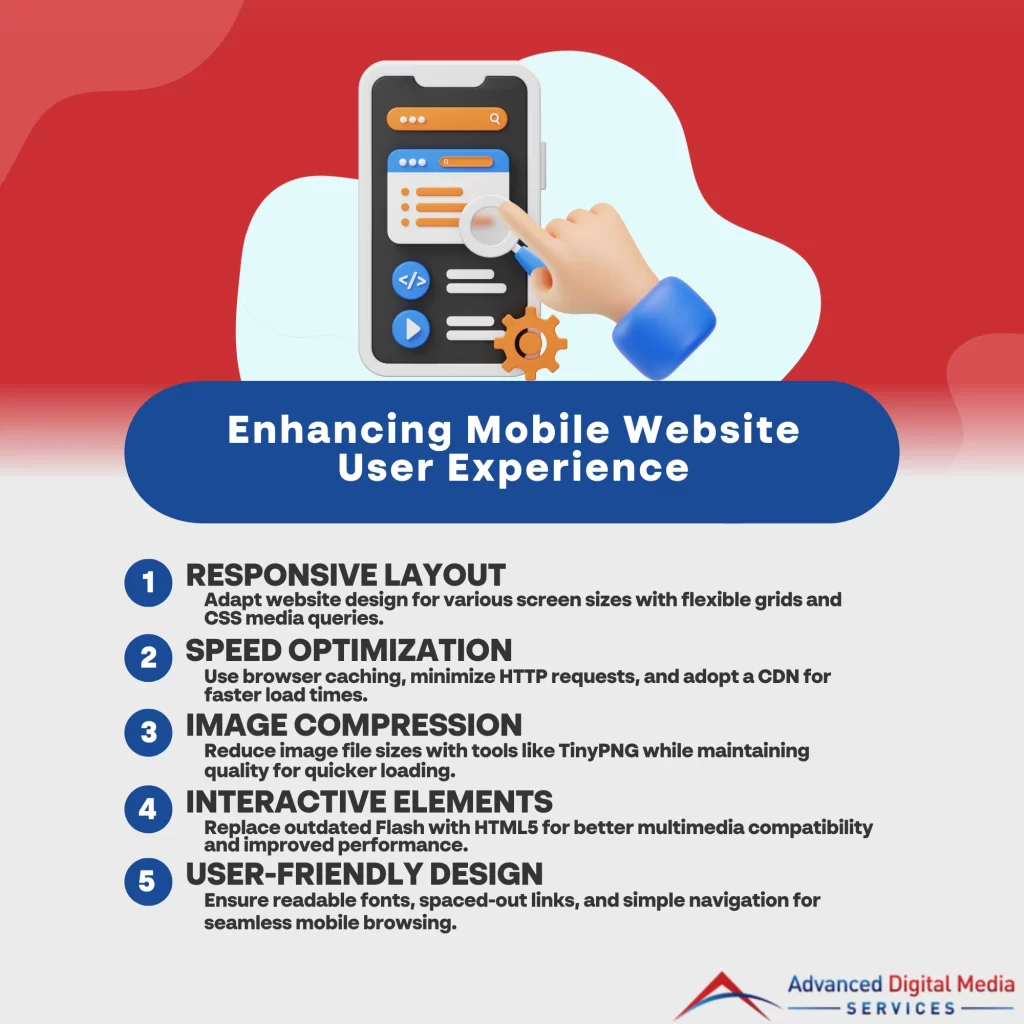To make your website mobile-friendly, start by implementing a responsive design that adapts to various screen sizes. Optimize loading speed by minimizing HTTP requests and leveraging browser caching. Compress images using tools like TinyPNG to enhance performance without sacrificing quality. Use HTML5 for multimedia instead of Flash, and avoid pop-ups that disrupt user experience. Ascertain text is readable with a minimum font size of 16 pixels and space out clickable elements. Regular testing across different devices helps identify issues. By following these strategies, you’ll enhance user interaction and boost your site’s visibility in search results. Discover further optimization tactics next.

Key Takeaways
- Implement responsive design using flexible grids and CSS media queries to adapt layouts for various screen sizes.
- Optimize website speed by leveraging browser caching, reducing HTTP requests, and using a CDN for faster content delivery.
- Compress images and use appropriate formats, ensuring quick loading times while maintaining quality across devices.
- Enhance user interaction by ensuring buttons are adequately sized, spaced, and clearly labeled for easy navigation.
- Regularly test your site on multiple mobile devices and gather user feedback to identify and resolve usability issues.
Develop a responsive layout
Developing a responsive layout is essential for guaranteeing your website performs well on all devices. To make your website mobile-friendly, you should focus on flexible grids and layouts. Use CSS media queries to adjust your design based on the device’s screen size. This means your website will automatically adapt to different resolutions, providing an ideal user experience across smartphones, tablets, and desktops.
Next, prioritize your content. Organize it in a way that’s easily digestible on smaller screens, guaranteeing that the most important information is readily accessible. Implement touch-friendly navigation elements, such as larger buttons and simplified menus. This helps users interact with your site smoothly, without frustration.
Finally, test your responsive layout on various devices and browsers. Tools like Google Mobile-Friendly Test can help identify areas for improvement. By regularly checking your layout, you can guarantee it meets the evolving standards of mobile usability.
Optimize website speed
How can you enhance your website’s performance? Optimizing website speed is vital, especially when you’re learning how to make your website mobile friendly. A slow-loading site can frustrate users, leading to higher bounce rates and lower conversion rates.
Start by leveraging browser caching. This allows returning visitors to load your site faster since their browser stores some data. Next, minimize HTTP requests by reducing the number of elements on your pages. Fewer requests mean quicker load times.
You should also consider using a Content Delivery Network (CDN). A CDN distributes your content across multiple servers, enabling users to access it from a server closer to them, thereby speeding up load times.
Additionally, verify your code is clean and efficient. Remove any unnecessary scripts and styles that can slow down performance. Finally, regularly test your site’s speed with tools like Google PageSpeed Insights, as this will help identify specific areas needing improvement. By focusing on these strategies, you’ll not only enhance your site’s speed but also create a more satisfying user experience, an essential element in how to make my website mobile friendly.
Compress images
One effective way to enhance your website’s mobile-friendliness is by compressing images. Large image files can considerably slow down your site’s loading speed, which negatively impacts user experience and search engine rankings. To make a website mobile friendly, you’ll want to guarantee your images are optimized without sacrificing quality.
Start by using tools like TinyPNG, JPEGmini, or ImageOptim. These applications can effectively reduce file sizes while maintaining visual integrity. You should save your images in appropriate formats—JPEG for photos and PNG for graphics with transparency.
Additionally, consider using responsive images with HTML attributes like “srcset” to serve different sizes based on the user’s device. This technique helps deliver the right image size, further improving load times.
Lastly, always test your images after compression to verify that they display correctly across various devices. A well-compressed image strategy not only enhances performance but also leads to better retention rates, contributing to an overall positive user experience. By implementing these practices, you’ll be well on your way to mastering how to make a website mobile friendly.
Use HTML5 instead of Adobe Flash
Optimizing your website for mobile use goes beyond image compression; it also involves updating your technology stack. One essential change you should make is to use HTML5 instead of Adobe Flash. While Flash was once a popular choice for web animations and interactive content, it’s now outdated and not supported on many mobile devices. This lack of compatibility can severely hinder your efforts to make your website mobile friendly.
HTML5 offers a modern solution, providing native support for multimedia elements like audio, video, and animations without requiring additional plugins. By leveraging HTML5, you guarantee your content is accessible across all devices and platforms, which is critical for user experience. Additionally, HTML5 is optimized for performance, loading faster, and reducing bounce rates—important factors for mobile users.
Switching to HTML5 also improves your website’s SEO potential. Search engines favor mobile-friendly sites, and using HTML5 can enhance your chances of ranking higher in search results. Ultimately, making this shift not only enhances user engagement but also boosts your visibility. So, to fully make your website mobile friendly, prioritize adopting HTML5 over the obsolete Adobe Flash.
Avoid pop-ups
Avoiding pop-ups is essential for enhancing the mobile user experience on your website. Mobile devices have limited screen space, and pop-ups can obstruct content, leading to frustration and increased bounce rates. To make your website mobile friendly, consider these strategies:
- Limit pop-ups: Use them sparingly to avoid overloading users.
- Implement exit-intent technology: This triggers pop-ups only when a user is about to leave the page, minimizing intrusiveness.
- Use banners instead: Consider less intrusive options like banners that provide information without obscuring the entire screen.
- Ensure easy dismissal: If you do use pop-ups, make sure there’s a clear and accessible way to close them.
Change button size and placement
How can you confirm your website’s buttons are effective for mobile users? To achieve a truly mobile friendly website design, you need to focus on button size and placement. Start by verifying your buttons are large enough for easy tapping. A minimum size of 44×44 pixels is recommended, as it allows users to interact without frustration. Avoid tiny buttons that require precision, as they can lead to a poor user experience.
Next, consider placement. Position important buttons, like “Buy Now” or “Sign Up,” within easy reach—ideally near the bottom of the screen where thumbs naturally rest. Make sure that buttons don’t overlap with other clickable elements, preventing accidental clicks.
Spacing is equally important; maintain adequate distance from buttons to avoid user errors. Utilize contrasting colors and clear labels to enhance visibility and usability.
Use a large and readable font
A large and readable font is essential for guaranteeing your website is accessible to mobile users. When you choose fonts that are easy to read, you enhance the user experience and improve engagement. A mobile friendly website test often shows that smaller fonts lead to higher bounce rates. Here are some key considerations for selecting the right font:
- Use a minimum font size of 16px: This guarantees that text is legible without zooming in.
- Opt for sans-serif fonts: These fonts are generally easier to read on screens compared to serif fonts.
- Maintain a good contrast: Guarantee your font color stands out against the background for better visibility.
- Limit the number of font styles: Using too many styles can create confusion and distract from your content.
Space out links
While designing your mobile-friendly website, it’s vital to space out links effectively. Proper spacing enhances usability, making it easier for users to navigate your site on smaller screens. When considering how to make existing websites mobile friendly, aim for at least 48 pixels of space around each clickable link. This distance prevents accidental clicks, which can frustrate users and lead to a poor experience.
Additionally, make certain that links are large enough to tap easily without zooming in. A minimum font size of 16 pixels is recommended for links, as it maintains readability while allowing users to interact comfortably. You should also keep your links consistent in style and color, making it easier for visitors to identify clickable elements.
Consider using buttons for important calls to action, as they can offer a more tactile experience on mobile devices. By spacing out links and optimizing their design, you enhance user experience, leading to higher engagement and conversion rates. Ultimately, making these adjustments is vital for anyone looking to improve their website’s mobile-friendliness and guarantee visitors can navigate with ease.
Declutter web design
After optimizing link spacing, the next step is to declutter your web design. A clean, organized layout is vital for creating a mobile-friendly website design that enhances user experience. When visitors encounter a cluttered interface, they’re likely to feel overwhelmed and leave your site. Simplifying your design not only improves navigation but also makes it easier for users to find the information they need.
Here are some essential tips to help you declutter effectively:
- Limit text: Use concise language and break up large chunks of text for readability.
- Reduce images: Keep only high-quality, relevant images that support your content.
- Streamline navigation: Use a simple menu structure with clear labels for easy access.
- Remove unnecessary elements: Eliminate distractions like excessive ads or pop-ups.
Test the website on mobile devices regularly
Regularly testing your website on mobile devices is essential for ensuring ideal performance and user experience. By doing this, you can identify any issues that may hinder the functionality of your mobile friendly website. Start by checking how your site appears on various devices, including different screen sizes and operating systems. This helps you understand how users interact with your content.
Utilize tools like Google’s Mobile-Friendly Test to evaluate how well your site performs on mobile. These resources will provide insights into loading speeds, usability, and any errors that need addressing. Keep in mind that user experience directly impacts your SEO rankings; a mobile friendly website not only attracts visitors but also retains them.
Moreover, consider gathering feedback from real users. Their experiences can highlight areas that automated tools might miss. Schedule regular tests after updates or design changes, ensuring your mobile-friendly website remains optimized. By maintaining a proactive testing routine, you’ll create a seamless experience for users, ultimately driving traffic and engagement. Remember, a well-tested mobile site reflects your commitment to quality and enhances your brand’s reputation.
Frequently Asked Questions
How Does Mobile-Friendliness Affect SEO Rankings?
Mobile-friendliness directly impacts your SEO rankings. Search engines prioritize sites that provide a seamless user experience on mobile devices, leading to higher visibility, increased organic traffic, and ultimately better conversion rates for your business.
What Tools Can I Use to Test Mobile Compatibility?
You can use tools like Google’s Mobile-Friendly Test, BrowserStack, and Responsinator to assess your website’s mobile compatibility. These tools help identify issues and guarantee your site performs at its best across various devices and screen sizes.
How Often Should I Update My Mobile Website Design?
You should update your mobile website design regularly, ideally every six months, to stay current with user trends, enhance performance, and guarantee compatibility. This keeps your site fresh, functional, and focused on user experience.
Can I Use Separate URLS for Mobile and Desktop Versions?
Yes, you can use separate URLs for mobile and desktop versions, but it’s essential to implement proper redirects and canonical tags. This approach guarantees search engines index your content correctly and maintains user experience across devices.
What Common Mistakes Should I Avoid When Making My Site Mobile-Friendly?
Avoid common mistakes like neglecting responsive design, using large images that slow loading, failing to optimize touch targets, and overlooking mobile user experience. Prioritize fast loading, intuitive navigation, and clear content to enhance usability and engagement.
Conclusion
In today’s mobile-centric world, making your website mobile-friendly is like opening the door to your digital success. By implementing a responsive layout, optimizing speed, and decluttering your design, you’re not just enhancing user experience; you’re also paving the way for increased engagement and conversions. Remember to test your site regularly on various devices to guarantee it performs flawlessly. With these strategies in place, you’ll captivate your audience and stand out in the crowded online landscape.






